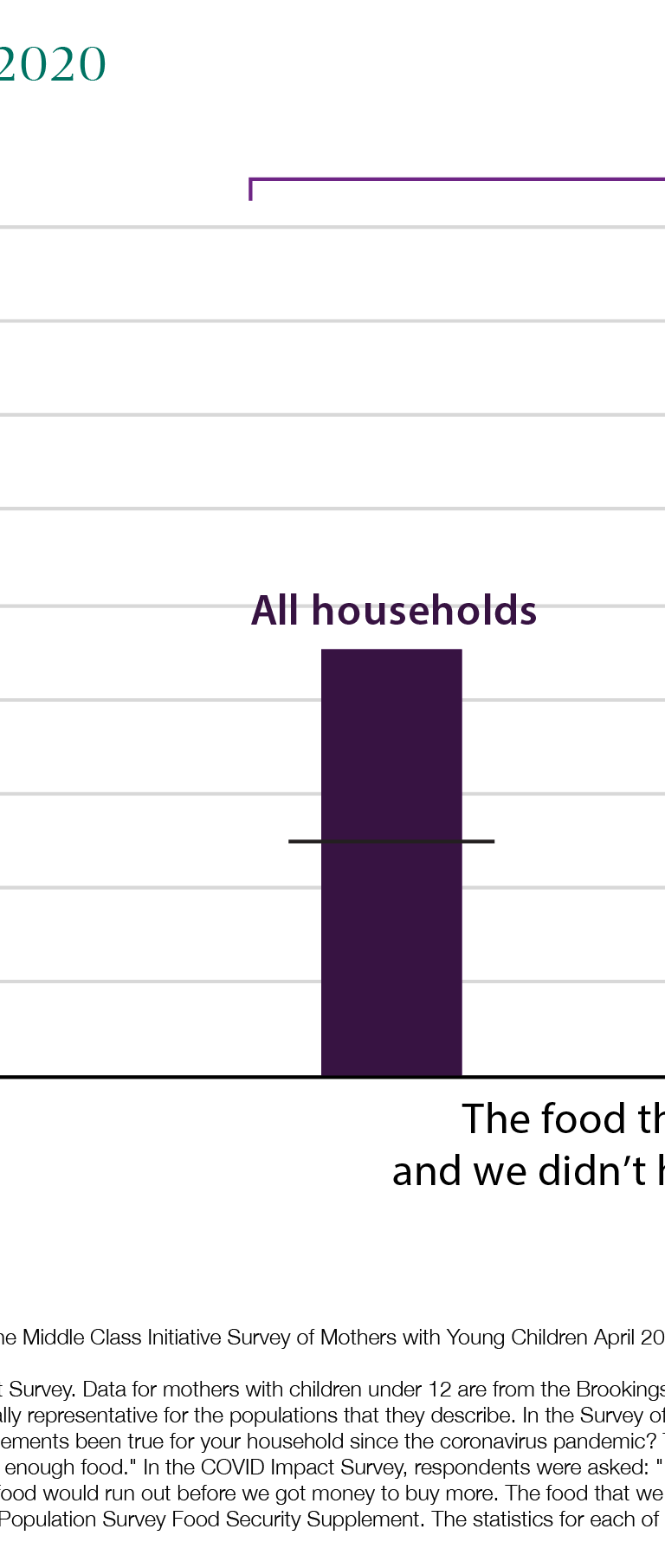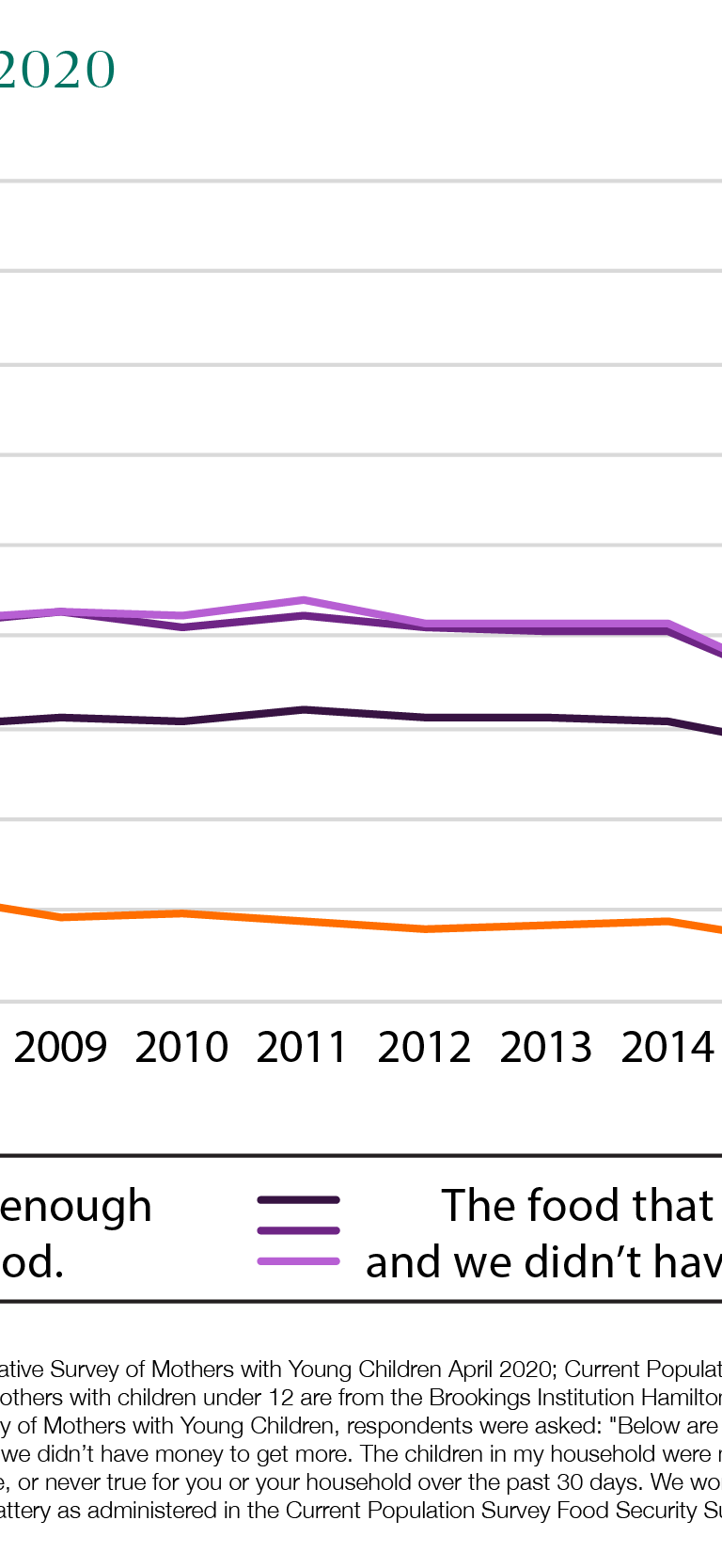Since the onset of the COVID-19 pandemic, food insecurity has increased in the United States. This is particularly true for households with young children.
I document new evidence from two nationally representative surveys that were initiated to provide up-to-date estimates of the consequences of the COVID-19 pandemic, including the incidence of food insecurity. Food insecurity occurs when a household has difficulty providing enough food due to a lack of resources.
The COVID Impact Survey and The Hamilton Project/Future of the Middle Class Initiative Survey of Mothers with Young Children asked validated questions taken from the U.S. Department of Agriculture’s (USDA) food security questionnaire in late April 2020.[i] Households and children are considered food insecure if the respondent indicates the following statements were often or sometimes true:
- The food we bought just didn’t last and we didn’t have enough money to get more.
- The children in my household were not eating enough because we just couldn’t afford enough food.
To compare April 2020 estimates of food insecurity with statistics from earlier time points, I use the same questions listed above to replicate these results with the Current Population Survey Food Security Supplement (FSS), the source of USDA’s official food insecurity statistics.[ii]
Figure 1 illustrates the high levels of food insecurity observed in the COVID Impact Survey and in the Survey of Mothers with Young Children. By the end of April, more than one in five households in the United States, and two in five households with mothers with children 12 and under, were food insecure. In almost one in five households of mothers with children age 12 and under, the children were experiencing food insecurity.
Rates of food insecurity observed in April 2020 are also meaningfully higher than at any point for which there is comparable data (2001 to 2018; Figure 2). Looking over time, particularly to the relatively small increase in child food insecurity during the Great Recession, it is clear that young children are experiencing food insecurity to an extent unprecedented in modern times.
Food Insecurity Has Deteriorated More among Households with Children
In the Survey of Mothers with Young Children, 17.4 percent of mothers with children ages 12 and under reported that since the pandemic started, “the children in my household were not eating enough because we just couldn’t afford enough food.” Of those mothers, 3.4 percent reported that it was often the case that their children were not eating enough due to a lack of resources since the coronavirus pandemic began.
By comparison, in the 2018 FSS, 3.1 percent of mothers with a child age 12 and under reported that their children were not eating enough because they could not afford enough food ever in the past twelve months. The incidence of hardship among children as measured by responses to this question has increased 460 percent.
But responses to this question alone do not fully capture child food insecurity. To estimate food insecurity, the USDA aggregates a battery of questions on access to food from the Current Population Survey. In total for 2018, 7.4 percent of mothers with children under the age of 12 had food insecure children in their household, more than double the share who said that the children in their household were not eating enough because they couldn’t afford enough food (3.1 percent). If the ratio between this single question and the overall measure of child food insecurity were to continue to hold today, 17.4 percent children not eating enough would translate into more than a third of children experiencing food insecurity.
The Survey of Mothers with Young Children found that 40.9 percent of mothers with children ages 12 and under reported household food insecurity since the onset of the COVID-19 pandemic. This is higher than the rate reported by all respondents with children under twelve in the COVID Impact Survey (34.4 percent) but the same as women 18–59 living with a child 12 and under (39.2 percent.) In 2018, 15.1 percent of mothers with children ages 12 and under affirmatively answered this question in the FSS, slightly more than the 14.5 percent that were food insecure by the complete survey. The share of mothers with children 12 and under reporting that the food that they bought did not last has increased 170 percent.
Food insecurity in households with children under 18 has increased by about 130 percent from 2018 to today. Using the COVID Impact Survey, I find that 34.5 percent of households with a child 18 and under were food insecure as of late April 2020. On this single question (“the food we bought didn’t last…”) in the 2018 FSS, 14.7 percent of households with children 18 and under affirmatively answered this question; this value is slightly higher than the overall rate of food insecurity among households with children 18 and under for that year.
High levels of food insecurity are not just a problem of households with children. Prior to the crisis, in 2018, 11.1 percent of households were food insecure and 12.2 percent of households answered the single question in the battery affirmatively. The Urban Institute’s Health Reform Monitoring Survey, in the field from March 25 to April 10, used the six-question short form food insecurity module and found that 21.9 percent of households with nonelderly adults were food insecure. By late April 2020, 22.7 percent of households reported in the COVID Impact Survey not having sufficient resources to buy more food when the food that they purchased didn’t last. Overall rates of household food insecurity have effectively doubled.
Families Need More Resources to Handle these Material Hardships
Policymakers must act to protect the health and well-being of the American people, especially children.
Luckily, food insecurity is an unusual policy challenge in that it recommends a clear solution. To reduce the number of people, including children, who have insufficient food due to a lack of resources, policymakers can supply the resources.
To increase food security, economic security, and economic stimulus, Congress should increase the generosity of food security programs immediately and ensure that benefits levels stay elevated consistent with economic data. Governors should work with USDA to implement these programs. Specifically:
Increase maximum Supplemental Nutrition Assistance Program (SNAP, formerly the Food Stamp program) benefits by at least 15 percent and double the minimum benefit;
- Provide SNAP emergency allotments, authorized under Families First, to those households that are eligible to receive the maximum level of benefits (more than 5 million children reside in these households and they have received no additional SNAP benefits during this crisis);
- Extend Pandemic-EBT through this summer and through at least the end of the 2020-2021 school year to ensure there are sufficient resources to purchase food in the event of ongoing schooling disruptions (Pandemic-EBT is a new program which provides the value of school meals as a grocery voucher to eligible families when schools are closed, a little more than $100 per child per month);
- Support families with children ages 5 and under through an additional SNAP multiplier or by broadening eligibility for Pandemic-EBT; and,
- Suspend SNAP work requirements for students and sustain the ABAWD SNAP work requirement suspension.
At the very beginning of the COVID-19 crisis, Diane Schanzenbach and I called for “at least” a 15 percent benefit increase to SNAP. Evidence presented in this piece reiterates that a 15 percent increase to SNAP should be the floor.
New nationally representative surveys fielded since the pandemic began show that rates of food insecurity overall, among households with children, and among children themselves are higher than they have ever been on record. Food insecurity represents an urgent matter for policymakers in the capitol and in state houses across the country. Food security programs, centrally SNAP and Pandemic-EBT, must be strengthened and expanded immediately.
[i] The COVID Impact Survey is a nationally representative survey conducted by NORC at the University of Chicago on behalf of the Data Foundation; it uses the AmeriSpeak panel and was in the field from April 20 to April 26, 2020. The Hamilton Project and the Future of the Middle Class Initiative, both affiliates of the Brookings Institution, conducted a nationally representative survey of mothers with children ages 12 and under using SurveyMonkey from April 27 to April 28, 2020. Technical documentation for the COVID Impact Survey can be found here. The Survey of Mothers with Young Children was developed by Lauren Bauer and Richard Reeves; Katherine Guyot and Emily Moss contributed substantially to the development of the survey and we acknowledge the contributions of The Hamilton Project, Future of Middle Class Initiative, and Economic Studies staff at the Brookings Institution. Both surveys used an iterative raking procedure to adjust the surveyed data to match demographic weighting variables obtained from the 2020 Current Population Survey. The COVID Impact Survey was weighted to reflect the U.S. population 18 and over while the Survey of Mothers with Young Children was weighted to reflect the population of mothers with at least one of their own children age 12 and under in their household. Additional technical documentation regarding the Survey of Mothers with Young Children is available from the author.
[ii] While this is a cleaner approach than comparisons to the complete food insecurity battery, the food insecurity time period about which the three surveys ask are each different. I have presented the most conservative estimates throughout this piece, comparing affirmative responses on single questions from the food insecurity battery for the last twelve months (FSS), the last 30 days (COVID Impact Study), and since the coronavirus pandemic began (Survey of Mothers with Young Children). Additional analyses are available from the author.
The Brookings Institution is committed to quality, independence, and impact.
We are supported by a diverse array of funders. In line with our values and policies, each Brookings publication represents the sole views of its author(s).









Commentary
The COVID-19 crisis has already left too many children hungry in America
May 6, 2020